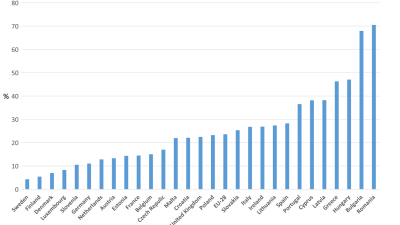These scatterplots allow you to compare the attitudes of various mutually exclusive groups as to which items and activities are necessities and which are not in the Northern Ireland necessities survey, 2011.
On a scatterplot, the x axis of the graph relates to one group and the y axis to the other. On the graph, each point represents an item or activity, and its position on the graph is determined by the percentage of each of the groups being compared who think that item is a necessity. If low and high scores from one group are coupled with low and high scores from the other group, the points on the graph will be close together along a straight line running at an angle of 45°, indicating a robust positive relationship (in other words, strong agreement). The more scattered the points are on the graph, the weaker the relationship (that is, less agreement). Items and activities falling in the top quadrant (shaded pink) are seen by both groups to be necessities and those in the bottom left quadrant are seen by neither as a necessity. Those in the top left quadrant are seen by the group represented on the y axis as a necessity but not the other and those in the bottom right quadrant are seen by the group represented on the x axis as a necessity but not the other.
Choose the groups you want to compare by selecting from the bottom left-hand boxes. So, for example, by selecting employment you can compare the attitudes of those who are in employment with those who are economically inactive. 'Adult/child' allows you to filter items and activities on the scatterplot by those for adults and those for children. 'Category' allows you to filter by items and activities. Selecting the significance box, marks differences which are statistically significant with a red (rather than blue) circle. Overall necessities shows items and activities which are seen by 50% or more of the whole sample as necessities by outlining the circle in black.
Overview
You will see that for all the comparisons, the points on the graph overwhelmingly follow the 45° line showing high levels of agreement. There are some differences between the various pairs being compared but relatively few where those differences are statistically significant.
For all pairings, the vast majority of points fall in the top right or bottom left quadrants (that is both groups are agreed as to whether the item is or is not a necessity). Of those items and activities seen by one group as a necessity but not the other (those in the top left and bottom right quadrants), there are only a very few where the differences are significant and even fewer where that items and activity is seen as a necessity by the whole sample (an overall necessity).
For a full analysis of these results see PSE working paper, anlaysisis series No.1, The Necessities of Life, by Grace Kelly, Mike Tomlinson et al.
Significance has in these tables been calculated at the 95% confidence level. Thus, at the 95 per cent confidence level, we can be 95% certain that the results are not due to chance.
Survey details
The necessities of life survey was carried out in Northern Ireland in February 2011 by the Northern Ireland Statistics and Research Agency (NISRA) in Northern Ireland. The sample size was 1,109 households.



 PSE:UK is a major collaboration between the University of Bristol, Heriot-Watt University, The Open University, Queen's University Belfast, University of Glasgow and the University of York working with the National Centre for Social Research and the Northern Ireland Statistics and Research Agency. ESRC Grant RES-060-25-0052.
PSE:UK is a major collaboration between the University of Bristol, Heriot-Watt University, The Open University, Queen's University Belfast, University of Glasgow and the University of York working with the National Centre for Social Research and the Northern Ireland Statistics and Research Agency. ESRC Grant RES-060-25-0052.






